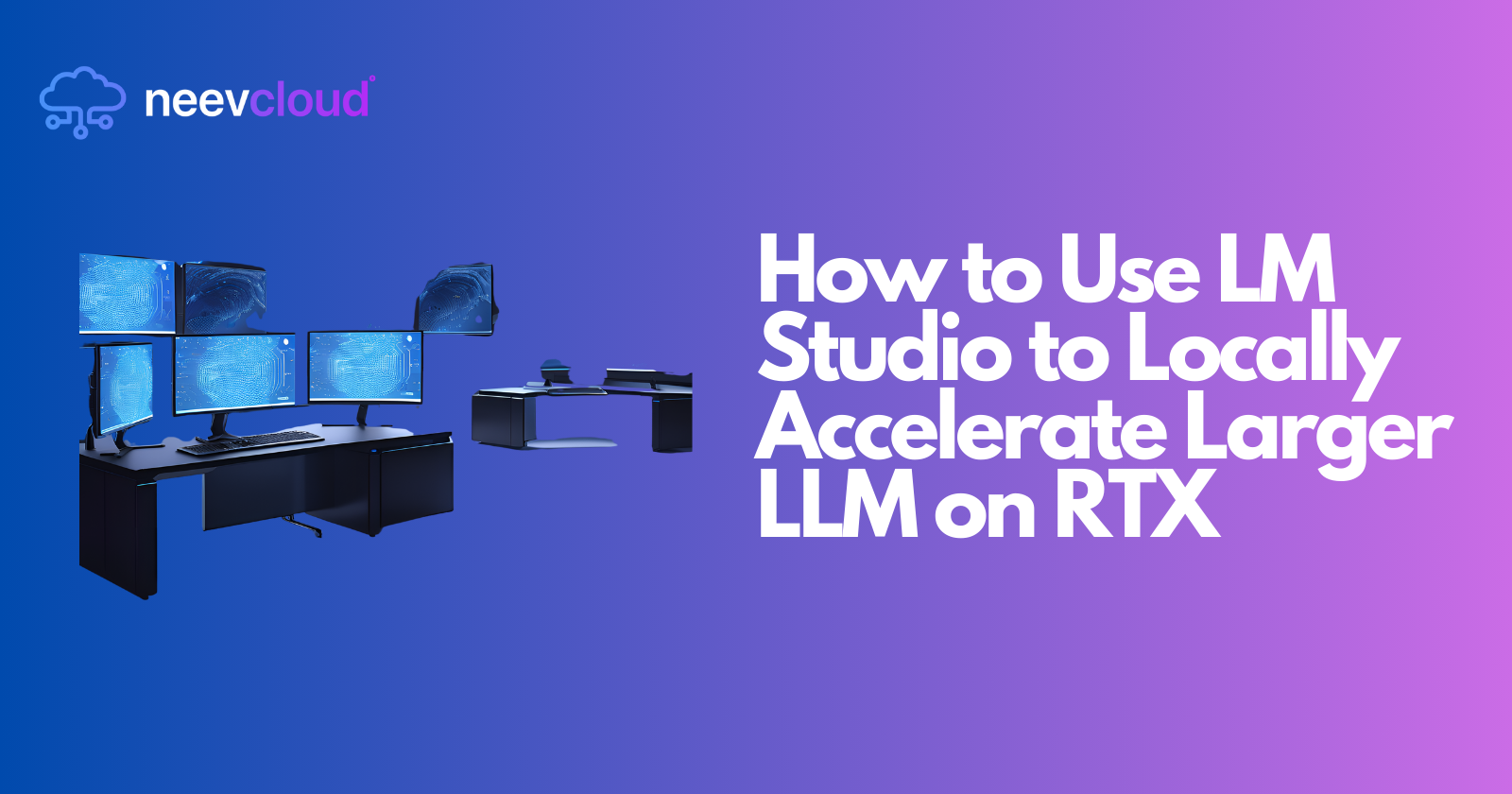How to Use LM Studio to Locally Accelerate Larger LLM on RTX
 Tanvi Ausare
Tanvi Ausare
As large language models (LLMs) continue to reshape the AI landscape, the demand for faster, localized processing solutions has surged. Leveraging NVIDIA’s RTX GPUs with LM Studio offers a high-performance approach for accelerating larger LLMs. This guide explores how you can use LM Studio to supercharge your LLMs, all while reducing dependence on cloud resources and improving privacy and data security.
Table of Contents
Introduction to LM Studio and Local Model Acceleration
Key Benefits of Local LLM Acceleration
Step-by-Step Guide to Setting Up LM Studio with NVIDIA RTX
Optimizing Performance for Larger Models
Challenges and Best Practices
Applications in AI Datacenters and Beyond
1. Introduction to LM Studio and Local Model Acceleration
What is LM Studio?
LM Studio is an open-source framework designed to enable users to run large language models on local machines, allowing for direct control over deployment and resource allocation.
It's an ideal solution for those who need to run LLMs without relying heavily on cloud solutions, balancing cost, privacy, and performance.
Why Accelerate LLMs Locally with RTX GPUs?
NVIDIA’s RTX GPUs, with their robust CUDA cores and tensor processing capabilities, provide a potent platform for local LLM acceleration.
By deploying LLMs on RTX GPUs, users can capitalize on efficient, high-speed model inference suitable for applications like customer support automation, real-time analytics, and more.
2. Key Benefits of Local LLM Acceleration
Reduced Cloud Dependency
Relying less on AI cloud resources can reduce costs and latency, and increase data security.
It allows companies to operate with independence from AI cloud providers for critical applications.
Increased Control and Privacy
Locally hosted LLMs offer control over sensitive data, an advantage in sectors like healthcare, finance, and government.
Ensures compliance with stringent data privacy regulations.
Improved Performance and Efficiency
Faster data processing and response times due to proximity of data to the processing units.
Optimizes resource utilization within AI datacenters, especially for companies already using NVIDIA GPUs.
3. Step-by-Step Guide to Setting Up LM Studio with NVIDIA RTX
Step 1: Install and Configure LM Studio
Download LM Studio: Obtain the latest version from the official LM Studio repository.
Install Dependencies: Ensure that your system has the necessary libraries for GPU computation, including CUDA and cuDNN.
Model Selection: Identify the model to deploy based on your use case. Larger models like GPT-3 or similar can benefit greatly from RTX acceleration.
Step 2: Integrate RTX GPU for Model Acceleration
CUDA Setup: Install NVIDIA CUDA Toolkit compatible with your RTX card.
Driver Configuration: Update GPU drivers to the latest version to ensure compatibility with LM Studio.
Benchmark GPU Capacity: Run initial benchmarks to assess the performance potential of the RTX GPU for large model processing.
Step 3: Optimize LM Studio for Local LLM Inference
Memory Allocation Settings: Configure LM Studio to optimize memory usage, particularly for handling larger models without compromising on inference speed.
Model Partitioning: For extra-large models, consider splitting model components between CPU and GPU to maintain balanced processing.
Enable Mixed Precision: Use mixed-precision (FP16) for LLM processing, allowing the RTX GPU to compute faster without a significant loss in accuracy.
4. Optimizing Performance for Larger Models
Use Batch Processing
- When possible, batch similar requests together to maximize GPU efficiency and reduce idle time.
Apply Memory-Efficient Attention Mechanisms
- Use memory-efficient variants of attention mechanisms, such as FlashAttention, to reduce memory consumption while speeding up computation.
Implement Model Pruning and Quantization
- Apply model pruning and quantization to reduce model size, which is beneficial for deploying on RTX GPUs with limited memory resources.
5. Challenges and Best Practices
Challenges
Memory Limitations: Even powerful GPUs like the NVIDIA RTX series have memory limits that can restrict the size of deployable models.
Compatibility Issues: Software libraries need to be compatible with both the hardware and the chosen LLM, which can involve extensive tuning and testing.
Resource Contention in Multi-GPU Setups: When running multiple large models, GPUs may compete for resources, affecting overall system efficiency.
Best Practices
Regular Driver and Software Updates: Ensure both the NVIDIA drivers and LM Studio are up to date for optimal performance and compatibility.
Dynamic Resource Allocation: Adjust the allocation of GPU resources based on workload demands, particularly in an AI datacenter.
Monitor Power Consumption: Use NVIDIA’s System Management Interface (nvidia-smi) to keep track of power usage, which can prevent overheating and ensure consistent performance.
6. Applications in AI Datacenters and Beyond
Data-Driven Customer Interactions
- With accelerated LLMs, businesses can deploy responsive chatbots, virtual assistants, and intelligent customer support that operate in real-time, providing better user experiences.
Enhanced Data Analysis and Insights
- LLMs can handle extensive datasets, generating real-time insights, summarizations, and translations that improve decision-making capabilities in industries like finance and e-commerce.
Healthcare Diagnostics and Support
- Accelerated LLMs can aid in diagnostics, medical record processing, and patient support systems, offering both efficiency and privacy essential for healthcare compliance.
Real-Time Language Translation for Global Operations
- LLMs can streamline communication in global enterprises by providing real-time language translation and summarization to enhance collaboration across teams.
Conclusion
By using LM Studio in conjunction with NVIDIA RTX GPUs, enterprises and AI datacenters can significantly boost the performance of large language models while maintaining control over data and costs. Whether your focus is privacy, speed, or compliance, accelerating LLMs locally offers unique advantages that position your AI solutions for scalable, efficient growth.
Subscribe to my newsletter
Read articles from Tanvi Ausare directly inside your inbox. Subscribe to the newsletter, and don't miss out.
Written by
